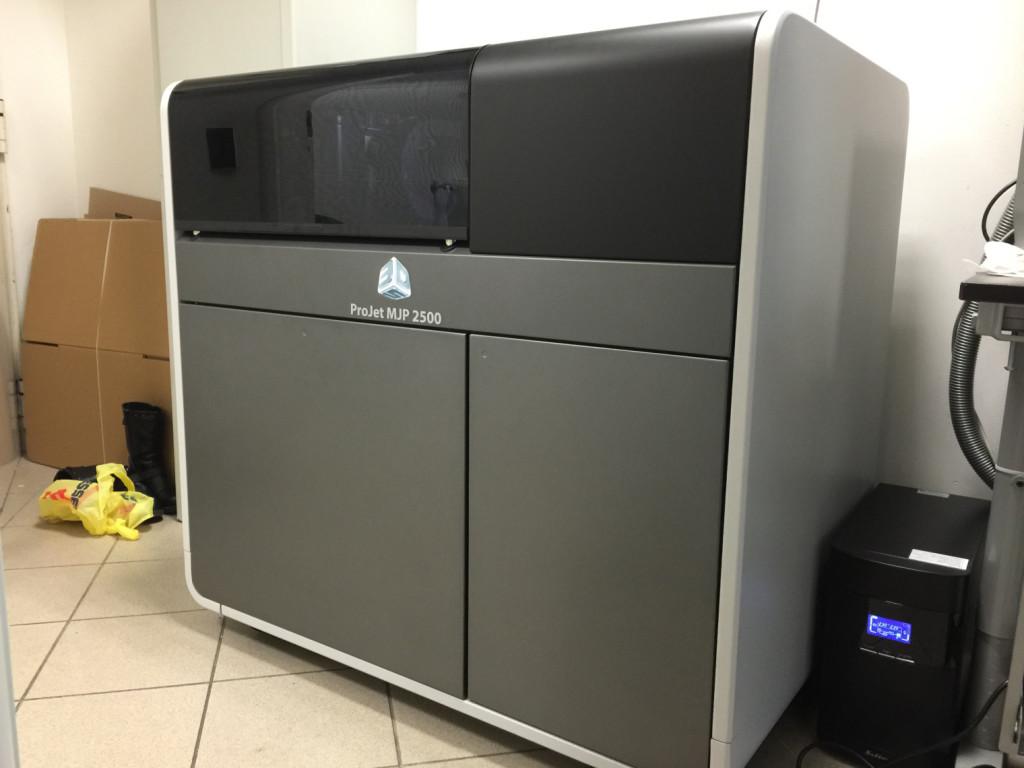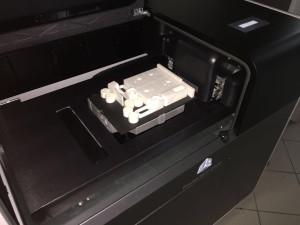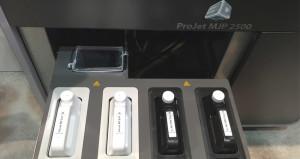 Thanks to Andrea Barchi, COO at Selltek, one of 3D Systems’ leading distributors in Europe, I recently had a chance to view a beta version of the new ProJet 2500, released just this month. This is the machine that the North Carolina based giant is counting on to challenge the Objet Eden’s dominance of the (relatively) low-cost inkjet 3D printing market. Judging by the first impressions gathered while working on the beta version at Selltek, 3D Systems is right in having great expectations for the ProJet 2500 line.
Thanks to Andrea Barchi, COO at Selltek, one of 3D Systems’ leading distributors in Europe, I recently had a chance to view a beta version of the new ProJet 2500, released just this month. This is the machine that the North Carolina based giant is counting on to challenge the Objet Eden’s dominance of the (relatively) low-cost inkjet 3D printing market. Judging by the first impressions gathered while working on the beta version at Selltek, 3D Systems is right in having great expectations for the ProJet 2500 line.
The ProJet MJP 2500 is possibly of the most interesting new products of 2016. It is a completely new machine and it represents the first concrete result of the acquisition that 3D Systems made, two years ago, of Xerox’s Oregon-based Solid Ink Engineering and Development teams. The fact that Xerox is involved is not casual as the ProJet 2500 could become as widespread a system as the copy machine.
In the name of Xerox
 Inkjet 3D printing uses a piezoelectric print head to control materials down to voxels that are the size of a few picoliters. It is currently the most advanced polymer 3D printing technology and works in a way that is similar to home 2D inkjet printers. Only, it creates 3D layers depositing digital polymer materials that are solidified through a light source.
Inkjet 3D printing uses a piezoelectric print head to control materials down to voxels that are the size of a few picoliters. It is currently the most advanced polymer 3D printing technology and works in a way that is similar to home 2D inkjet printers. Only, it creates 3D layers depositing digital polymer materials that are solidified through a light source.
The ProJet MJP 2500 is based on 3D Systems’ version of inkjet 3D printing, that is MultJet Printing (MJP). However the cost and size of this systems mean that they are going to replace the ProJet 1500, which is a DLP-based a system. In short this means that the new machine may not become a 3D printer for all but certainly for many.
“Honestly, when I saw it at CES in January I was really excited,” says Andrea Barchi. “It is a smaller machine, completely user friendly, able to print in very high quality and with 5 beautiful materials. That’s because the ProJet 2500 uses next-generation resins similar to those seen on the larger 5500X. At present, these include ABS-like, polypropylene-like, a beautiful semi-transparent and, finally black and white elastomers.”
Like a smartphone
 The 2500 is also the third machine supported by the new 3DSPRINT software (also currently in beta). The latest 3D Systems software integrates multi-machine management, while implementing fixing and editing functions. It is a very intuitive software. Once the print job is loaded, 3DSPRINT works as a Client Manager to monitor and manage the print queues of all the machines on a company’s network.
The 2500 is also the third machine supported by the new 3DSPRINT software (also currently in beta). The latest 3D Systems software integrates multi-machine management, while implementing fixing and editing functions. It is a very intuitive software. Once the print job is loaded, 3DSPRINT works as a Client Manager to monitor and manage the print queues of all the machines on a company’s network.
The display, which is based on the Android operating system for even greater accessibility, provides all the necessary information. A complete operator menu enables users to to easily perform maintenance and material change. 3D Systems’ management promises very little waste of time and materials during this operation.
Style first
 From the aesthetic side, the ProJet 2500 presents the same “family feeling” of all the more recent 3D printers by 3D Systems. It is not as small as it looks in photos and the exterior is stylish and modern. The work area is anything but small, just a little smaller than that of its older sister, the industry leading ProJet 3600 (295 x 211 x 142 mm). It adds a resolution of 800 x 900 x 790 dpi with down to 32-micron layers.
From the aesthetic side, the ProJet 2500 presents the same “family feeling” of all the more recent 3D printers by 3D Systems. It is not as small as it looks in photos and the exterior is stylish and modern. The work area is anything but small, just a little smaller than that of its older sister, the industry leading ProJet 3600 (295 x 211 x 142 mm). It adds a resolution of 800 x 900 x 790 dpi with down to 32-micron layers.
The printing platform can be used on both sides, an ingenious automatic retention system locks the platform in at the start. The inkjet print head runs along three lanes. If the parts to be produced do not extend beyond the first section, the ProJet 2500 works at maximum speed. In case more space is needed the machine will run its print head on two or even al three lanes. In this case, the machine is still very fast and the junction point between the parts is invisible to the naked eye.
Materials matter
 The new ProJet 2500 series can currently use 5 new VisiJet M2 materials. These are VisiJet RWT (Rigid White), VisiJet RBK (Rigid Black), VisiJet RCL (Rigid Clear), EBK VisiJet (Elastomeric Black) and VisiJet ENT (Elastomeric Natural). The two elastomers, only available on the Plus version, offer a sensational performance of up to 650% maximum elongation at break
The new ProJet 2500 series can currently use 5 new VisiJet M2 materials. These are VisiJet RWT (Rigid White), VisiJet RBK (Rigid Black), VisiJet RCL (Rigid Clear), EBK VisiJet (Elastomeric Black) and VisiJet ENT (Elastomeric Natural). The two elastomers, only available on the Plus version, offer a sensational performance of up to 650% maximum elongation at break
The polymerization process is activated by two LED emitters mounted under the head. All calibration and alignment processes are managed automatically by the machine, leaving very few manual tasks to be undertaken by human operators.
The ProJet 2500 is available in two versions, Standard and Plus. The first allows you to print in hard black and white material; the second also supports the transparent material and the two elastomers. As for its competitor’s systems, an upgrade can be performed at any time.
“The cartridge lading system is state of the art,” Andrea says. “along with top notch resolution capabilities this could worry not just the competition but also the Projet’s ‘older sisters’ currently on the market. In the first tests that carried there seems to be no substantial qualitative differences between the upper surfaces and those in contact with the support material. This time in 3D Systems we are really breathing in the fresh scent of innovation and we cannot wait to have the 3D printer available to purchase.”
Subscribe to Our Email Newsletter
Stay up-to-date on all the latest news from the 3D printing industry and receive information and offers from third party vendors.
Print Services
Upload your 3D Models and get them printed quickly and efficiently.
You May Also Like
The Market and Industry Potential of Multi-Material 3D and 4D Printing in Additive Electronics
Additive manufacturing leverages computer-based software to create components for products by depositing either dielectric or conductive materials, layer by layer, into different geometric shapes. Since its birth in the 1980s,...
3DPOD 262: Bio-inspired Design for AM with Dhruv Bhate, Arizona State University
Dhruv Bhate is an associate professor at Arizona State University. There, he looks at structures, materials, and design. Previously, he worked at PADT as well as in the semiconductor and...
3DPOD 261: Tooling and Cooling for AM with Jason Murphy, NXC MFG
Jason Murphy´s NXC MFG (Next Chapter Manufacturing) is not a generalist service; instead, the company specializes in making tooling. Using LPBF and binder jet, the company produces some of the...
3DPOD 260: John Hart on VulcanForms, MIT, Desktop Metal and More
John Hart is a Professor at MIT; he´s also the director of the Laboratory for Manufacturing and Productivity as well as the director of the Center for Advanced Production Technologies....
































